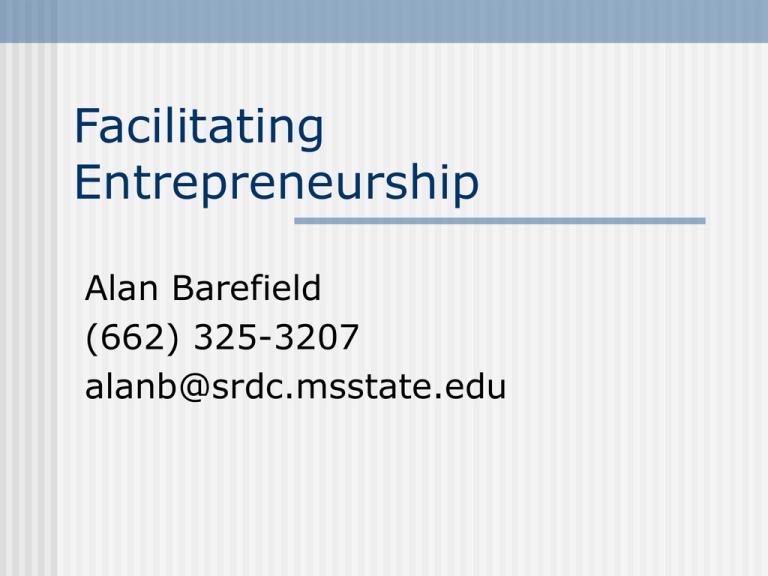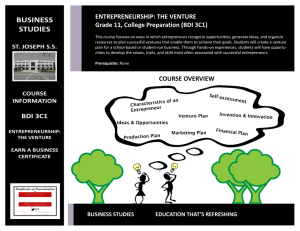Facilitating Entrepreneurship
advertisement

Facilitating Entrepreneurship Alan Barefield (662) 325-3207 alanb@srdc.msstate.edu What is Entrepreneurship? The quest for implicit personality traits and factors (Chell et al, 1991) is over. We can now recognize that entrepreneurship is a dynamic form of social and economic behavior in which people respond to environmental signals about the availability of opportunities and the resources with which they can be exploited. Rae and Carswell What is Entrepreneurship? An entrepreneur is a person who sees opportunity, sizes up its value, and finds the resources to make the most of it. Jim Nelson University of Idaho Characteristics of Entrepreneurs Entrepreneurs have: A passion for what they do The creativity and ability to innovate A sense of independence and selfreliance (Usually) a high level of self confidence A willingness and capability (though not necessarily capacity or preference) for taking risks Characteristics of Entrepreneurs Entrepreneurs do not (usually) have: A tolerance for organizational bureaucracies A penchant for following rules A structured approach to developing and implementing ideas The foresight to plan a course of action once the idea is implemented and established Specific entrepreneurship areas Business ideas and development Products or services Enterprises Marketing Operations Management Financial management Marketing example Custom slaughterhouse Specialty slaughter and butcher to Hispanic, Muslim, and BBQ markets Reproductive tracts to animal science departments Beef eyes to medical schools Goat hides to specialty leather curer Consignment sales of ostrich and bison Entrepreneurs vs. managers Management skills include: Technical production skills Knowledge of marketing skills Organizational and human resource skills Financial skills Ability to develop simple tasks to solve complicated problems Ability to find complete and efficient solutions to problems What can we do? Are we able to pick out true entrepreneurs? Our models don’t allow us to predict the success of these persons They typically get marked off as not being in touch with reality Our job as federal and state agencies may be better suited to providing educational programs on management skills Where is the learner? Are they at a teachable moment? Unaware to Aware Early Stage Pre-launch Operating & Launch Start-up Growth Harvest or Exit •Where is the learner along this timeline? •Where do you want the learner to be? •Where should the learner be? Examples Engineers Unaware to Aware Early Stage Business Students Family Businesses Pre-launch Operating & Launch Start-up Growth Harvest or Exit Practicing Entrepreneurs Provide exposure and raise awareness Unaware to Aware Early Stage Pre-launch Operating & Launch Start-up •Potential methods Growth •Seminar series •Large “sage on stage” courses •Weekend courses •Short distance learning courses •Mentoring •Simulations Harvest or Exit Provide exposure and raise awareness Unaware to Aware Early Stage Pre-launch Operating & Launch Start-up •Additional Potential methods Growth •Lectures with materials, texts, videos •Guest speakers •Face-to-face •Teleconferencing •Virtual guest speaker •Additional readings, outside experiences Harvest or Exit Provide exposure and raise awareness Unaware to Aware Early Stage Pre-launch Operating & Launch Start-up Growth Harvest or Exit •Develop building block course •management, marketing, finance, accounting, operations •Customize these courses to the audience •Develop self-paced learning modules Provide exposure and raise awareness Unaware to Aware Early Stage Pre-launch Operating & Launch Start-up Growth Harvest or Exit •Develop required sequential courses •Utilize an experiential learning environment •Mentoring •Business consulting •Business plan project •Incubators Available Entrepreneurship Programs and Curricula Exploring Entrepreneurship What do these curricula have in common? They teach business management skills! And try to instill a sense of discipline and order into business planning! What should be taught? Business plan development Organizational plan Management plan Marketing plan Operations and production plan Financial plan Overall growth plan What should be taught? Market development What is marketing? Marketing versus advertising Marketing on a shoestring Merchandising, display, and storefront layout Mass media marketing including radio, TV, newspaper, flyers, etc. What should be taught? Financial management Types of financial statements (income statement, balance sheet, cash flow, budget) and their relationship to the firm’s health Financial record keeping strategies Financial performance evaluation Financial health improvement strategies What should be taught? Organizational plan Who is the management team and what is their experience? Who will make the decisions in specific areas? How will overall planning versus day-today operations be divided among the team? What should be taught? Operations and production mgt What will be produced and how will it be produced? What types of quality control standards will be used? How will products be packaged and shipped? Labor What should be taught? Labor Who do you want to hire? What skills do they need? How is the compensation plan developed and what are its components? Is there a promotion or performance incentive plan? What is the disciplinary plan? The Business Plan Many potential business people focus too much on the numbers Focus on these factors: The People The Opportunity The Context Risk and Reward Why not numbers? Entrepreneurs are wildly optimistic Numbers are usually padded Investors know about this and discount the numbers Leads to a cycle of inaccuracy Plan should contain some numbers that demonstrate a business model such as manufacturing yield The People Who are the “people?” The men and women starting and running the business Also includes outside parties who provide key services or resources • Accountants • Lawyers • Suppliers Questions to answer Where are the founders from? Where have they been educated? Where have they worked – and for whom? What have they accomplished? What is their reputation in business? What experience do they have that is relevant to this business? Questions to answer What skills, abilities, knowledge do they have? How realistic are they about the venture’s chance of success and failure? Who else needs to be on the team and do they recognize this? Can they recruit high-quality people? Questions to answer How do they respond to adversity? Do they have the internal fortitude to make the difficult choices that lie ahead? How committed are they to the venture? What are their motivations? The Opportunity Is the market: Large? Rapidly growing? Both? Is the industry now, or can it become, structurally attractive? It is easier to gain market share from a growing market than from a stagnant one Questions to answer Who is the customer? How does the customer make purchasing decisions? To what degree is the product a compelling purchase? How will pricing be determined? How will the product or service reach all targeted customer segments? Questions to answer How much does it cost (in resources and time) to acquire a customer? How much does it cost to support an acquired customer? How easy is it to retain a customer? How much does it cost to produce and deliver the product or service? Questions to answer Who are the venture’s competitors? What resources do the competitors control? Strengths and weaknesses? How will they respond to the venture entering the business? How can the new venture respond to its competitors’ response? Who else might be able to exploit the same opportunity? Can you form alliances with potential or actual competitors? The Context What is the big picture in terms of these trends? Regulatory environment Interest rates Demographic trends Inflation Other factors that change but cannot be controlled by the entrepreneur Addressing context Awareness of venture’s context and how it affects the venture How the changing of context will likely affect the business What will management do if the context grows unfavorable? How can management affect context in a positive way? Risk and Reward All sane people want to avoid risk Entrepreneurs want to capture the reward and give the risk to others Need to show people, opportunity, and context from both good and bad perspectives Talk about the end of the business process Warning Signs for Pending Financial Difficulties Significant increase in the level of accounts payable Significant increase in the frequency and amount of impulse purchases Decrease in the level of available working capital Record keeping practices become less important Warning Signs for Pending Financial Difficulties Hides a large portion of financial activities from other family members and lenders Diversion of sales proceeds Living expenses increase rapidly and expenditures for capital assets increase Works less and plays harder Domestic situation changes Attributes of Success Decisions are made on the bottom line Gross revenue is not treated like manna from heaven If a task can’t be accomplished in-house in a cost effective manner, outsource it Attributes of Success They are not timid about tooting their own horn about their products or services Does not dwell on the challenges of the competition; realize that some have it and some don’t References Clark D. Garland, U of Tennessee James R. Nelson, U of Idaho, Teaching Entrepreneurship to an Extension Audience – What to teach and how to teach it, 2003 AAEA meetings, Montreal, Canada. William A. Sahlman, Harvard U, How to Write a Great Business Plan, Harvard Business Review, July-August, 1997. Deborah H. Streeter, Cornell U, Teaching Entrepreneurship in a Formal Academic Setting – What to teach and how to teach it, 2003 AAEA meetings, Montreal, Canada



